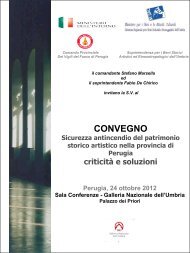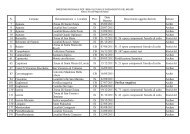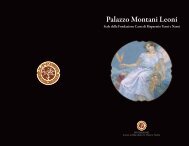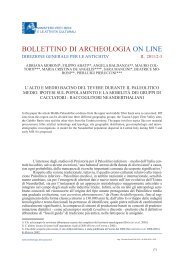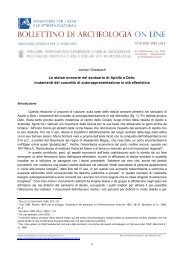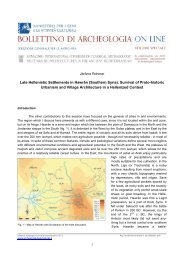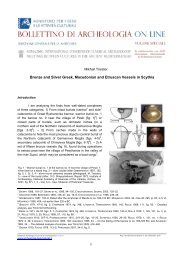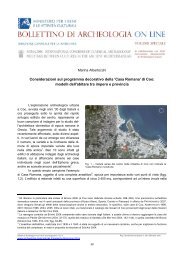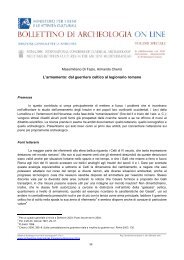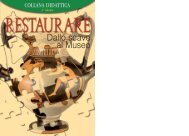Siculo-Punic Coinage and Siculo-Punic Interactions
Siculo-Punic Coinage and Siculo-Punic Interactions
Siculo-Punic Coinage and Siculo-Punic Interactions
You also want an ePaper? Increase the reach of your titles
YUMPU automatically turns print PDFs into web optimized ePapers that Google loves.
Jonathan R. W. Prag<br />
<strong>Siculo</strong>-<strong>Punic</strong> <strong>Coinage</strong> <strong>and</strong> <strong>Siculo</strong>-<strong>Punic</strong> <strong>Interactions</strong><br />
The reflections presented in this paper derive from a survey of some of the recent literature on the<br />
coinage of <strong>Punic</strong> Sicily. They are offered from the perspective of a historian exploring questions such as:<br />
‘what is meant by “<strong>Punic</strong> Sicily”?’, ‘how does one determine what is “<strong>Punic</strong>”?’, <strong>and</strong> ‘what was the relationship<br />
between that which is “<strong>Punic</strong>” <strong>and</strong> the rest of the isl<strong>and</strong>?’ 1 . The material discussed is essentially secondary<br />
<strong>and</strong> I make no pretence to particular expertise in the realms of archaeology or numismatics. However, the<br />
problems presented by the coinage seem to raise useful <strong>and</strong> interesting questions that are of no less interest<br />
to the archaeologist than to the historian when it comes to thinking about interactions in <strong>Punic</strong> Sicily.<br />
<strong>Coinage</strong> lies at the interface between political, economic, <strong>and</strong> cultural history, <strong>and</strong> it is the ways in which it is,<br />
<strong>and</strong> is not, used for elucidating both our underst<strong>and</strong>ing of the nature of Carthaginian imperialism in Sicily,<br />
<strong>and</strong> the interactions between <strong>Punic</strong> <strong>and</strong> non-<strong>Punic</strong> communities in Sicily, that I wish to explore in this paper.<br />
These two subjects, the one superficially more political, the other more cultural <strong>and</strong> economic, are<br />
inextricably intertwined, such that although the first part of the paper focuses upon readings of Carthaginian<br />
imperialism, <strong>and</strong> the second on cultural <strong>and</strong> economic interactions, the two are never wholly separated out in<br />
the discussion that follows.<br />
<strong>Siculo</strong>-<strong>Punic</strong> coinage presents a number of apparent paradoxes, most obvious amongst which is the<br />
notion that Carthaginian coinage finds its beginnings, c. 410 BC, in western Sicily (perhaps at Entella) 2 . This<br />
coinage is associated with the major expedition to reassert Carthaginian control in western Sicily 3 , <strong>and</strong> with<br />
the installation of (often Campanian) mercenary garrisons, with the result that it is understood above all in<br />
the context of political <strong>and</strong> military decisions. In other words, the traditionally mercantile Carthage enters the<br />
world of monetary production for apparently political <strong>and</strong> military reasons, rather than primarily economic<br />
motives 4 . However, the paradox should be rejected. Quite apart from the obvious response that political <strong>and</strong><br />
military decisions can be motivated by economic considerations, ‘mercantile’ Carthage is a very worn topos.<br />
The paradox exists by virtue of the stereotype (hence ‘apparently’). Since the evidence points in a different<br />
direction, <strong>and</strong> the contradiction arises purely from the stereotype, if we ab<strong>and</strong>on the stereotype (as being a<br />
literary construct of Carthage’s detractors), then the paradox simply disappears. As we shall see in a<br />
moment, the coinage can readily be understood as a political statement by Carthage, directed against<br />
1 And as such belong in the context of an ongoing work-in-progress: see PRAG 2006, 2010 (forthcoming A).<br />
2 For the suggested siting of the mint at Entella, see LEE 2000; a more general discussion of the Sicilian beginnings in, e.g., MILDENBERG<br />
1992.<br />
3 For which see, e.g., HANS 1983, LEWIS 1994, ANELLO 2002.<br />
4 The paradox is repeatedly commented upon, e.g., CUTRONI TUSA 2008, 398; also VISONÀ 1998, 4.<br />
Bollettino di Archeologia on line I 2010/ Volume speciale A / A2 / 2 Reg. Tribunale Roma 05.08.2010 n. 330 ISSN 2039 - 0076<br />
www.archeologia.beniculturali.it<br />
1
J. R. W. Prag – <strong>Siculo</strong>-<strong>Punic</strong> <strong>Coinage</strong> <strong>and</strong> <strong>Siculo</strong>-<strong>Punic</strong> <strong>Interactions</strong><br />
Syracuse - although that is not to rule<br />
out, e.g., economic considerations 5 . Furthermore,<br />
the coinage raises significant<br />
questions for our underst<strong>and</strong>ing of the<br />
cultural dynamics at play, since the<br />
coinage is visibly ‘Greek’, or better ‘Sicilian’,<br />
from both a technical (protruding<br />
flans, unfixed dies (fig. 1), centrality of<br />
the Attic tetradrachm to the issue) <strong>and</strong><br />
an iconographic perspective (clearly Sikeliote,<br />
particularly Syracusan, types) 6 .<br />
A no less complex picture of<br />
political <strong>and</strong> cultural interplay can be<br />
found in the earlier coinage of the Phoenicio-<strong>Punic</strong><br />
settlements on the isl<strong>and</strong><br />
(Motya, Panormus, Solus). These are<br />
the first of the western Phoenicio-<strong>Punic</strong><br />
settlements to begin minting, <strong>and</strong> they<br />
also do so very clearly within the Sikeliote<br />
sphere - for a start, they<br />
employ Greek legends, although<br />
these are soon replaced<br />
with <strong>Punic</strong>. The independent<br />
coinage of Motya<br />
begins, significantly perhaps,<br />
after the Carthaginian<br />
defeat at Himera in 480 BC -<br />
traditionally seen as the end<br />
of the first phase of Carthaginian<br />
intervention in Sicily,<br />
which resumes with<br />
their return (with coinage) in<br />
410 BC. The interaction vi-<br />
sible between the Motyan coinage <strong>and</strong> that of Greek (e.g. Himera) <strong>and</strong> Elymian (e.g. Segesta) communities<br />
in western Sicily, <strong>and</strong> even with, e.g., Populonia in Etruria, as suggested by the affinity of the coin types, is<br />
so close that scholars have often suggested shared workshops, or the physical transfer of dies (fig. 2) 7 . The<br />
patterns implied by the coinage compare well with the material evidence for the cultural autonomy of Motya<br />
from Carthage (suggested by elements as diverse as relief sculpture, onomastics, epigraphic formulae, <strong>and</strong><br />
script) 8 . The extent of the integration of the Motyan coin-types with other (non-<strong>Punic</strong>) cities in the region<br />
should be considered alongside, for instance, the recent suggestion that Motya was one of the western<br />
Mediterranean centres for the production of terracotta altars 9 , or the evidence from the Birgi necropolis of<br />
5<br />
As remarked, e.g., by MILDENBERG 1992, 292.<br />
6<br />
The technical parallels are lucidly presented in MILDENBERG 1992; the iconographic parallels are discussed further below, <strong>and</strong> more<br />
fully in, e.g., CUTRONI TUSA 2000a, 259–61.<br />
7<br />
Principal study is JENKINS 1971 (compare, e.g., plate 2: Motya I.15 with Segesta B); cf. MANFREDI 2000, 12–13. For discussion of the<br />
toponym ‘Motya’ <strong>and</strong> coin-legends in this context, e.g., NENCI 1993.<br />
8<br />
In addition to the references conveniently collected in BONDÌ 1990-91, 221 nn. 31-33, see e.g. MOSCATI <strong>and</strong> UBERTI 1981, 61–71, <strong>and</strong><br />
MOSCATI 1995.<br />
9<br />
See BONDÌ 2000, 88–9. Cf. the observation regarding the mix of ‘<strong>Punic</strong>’ <strong>and</strong> Sicilian ‘Greek’ figured terracotta types in CIASCA <strong>and</strong> TOTI<br />
1994, 7, or the comments of TOTI 2002, II, 555 on the fourth-century ceramics from Motya.<br />
Fig. 1 - <strong>Siculo</strong>-<strong>Punic</strong> tetradrachm, silver, 17.37 gr, 320-300 BC (Jenkins ser.<br />
3a, no.186). Head of Arethusa to left, four dolphins / horse head to left, palmtree,<br />
‘MMḤNT. Red lines indicate the die axis on each face, illustrating both the<br />
protruding flans <strong>and</strong> the non-fixed die. This example from GATLIN 2009,<br />
http://imagedb.coinarchives.com/img/stacks/stacks_jan09/image02086.jpg<br />
(accessed 15.4.09).<br />
Bollettino di Archeologia on line I 2010/ Volume speciale A / A2 / 2 Reg. Tribunale Roma 05.08.2010 n. 330 ISSN 2039 - 0076<br />
www.archeologia.beniculturali.it<br />
2<br />
Fig. 2 - Example of imitation of Segesta type<br />
at Motya (NB for actual die-linkage, see<br />
JENKINS 1971, 27–28).<br />
a) Segesta example: didrachm, late C5 BC,<br />
silver, 9.02 gr. Hound to right, st<strong>and</strong>ing on<br />
stag’s head <strong>and</strong> seizing by the nose; above,<br />
head of river-god to right / ΕΓΕΣΤΑ[ΙΟΝ],<br />
head of nymph to right, ivy-leaf behind; cf.<br />
JENKINS 1971, pl.4, C. This example from<br />
GATLIN 2009,…………………………………….<br />
http://imagedb.coinarchives.com/img/nac/033<br />
/00083q00.jpg (accessed 15.4.09).<br />
b) Motya example: didrachm, late C5 BC,<br />
silver, 8,37 gr. Similar to (a), without legend;<br />
cf. JENKINS 1971, Motya II, 36. This example<br />
from GATLIN 2009,………………………………<br />
http://imagedb.coinarchives.com/img/munzen<br />
/020/00004q00.jpg (accessed 15.4.09).
XVII International Congress of Classical Archaeology, Roma 22-26 Sept. 2008<br />
Session: <strong>Punic</strong> interactions: cultural, technological <strong>and</strong> economic exchange between <strong>Punic</strong> <strong>and</strong> other cultures in the Mediterranean<br />
mixed material culture at the site 10 , or Diodorus’ report of Greek Sicilians prepared to st<strong>and</strong> alongside the<br />
Motyans against Dionysius I in 397 BC (Diod. Sic. 14.53.4, cf. 14.77.55).<br />
This raises a basic question, which is one on which I would like to focus: to what extent can the<br />
interactions implied by the coinage provide models for other interactions, or at least heuristic tools for<br />
thinking about possible interactions? If, for example, a coin-type, or a minting technique, travels from one<br />
community to another, does that suggest, at one extreme, political or economic interventions at a state level,<br />
or, at the other end of the spectrum, merely the migration of a lone craftsman? Is it a question of movements<br />
of people, or skills, or ideas, or cultural ideals, or, should such interactions be thought about only at the level<br />
of state decisions about political or economic policy? The latter are readily accepted as motives in the<br />
production of coinage, but the inevitable consequence of doing so, quite apart from the inevitable boundaries<br />
created by the specialist nature of numismatic studies, is that the implications of the coinage for the<br />
movements of peoples <strong>and</strong> the exchange of ideas <strong>and</strong> ideals are often either ignored or else set to one side<br />
as being of either limited relevance or alternative significance compared to other material culture interactions<br />
(visible in pottery, architecture, etc.). The reality of course is that more than one of these aspects is likely to<br />
be at work at any one time. The conclusion is therefore an unsurprising one, that either to make a full<br />
assessment of the significance of patterns in the coinage, or to evaluate the interactions visible in the<br />
archaeology, requires the full integration of these different media. Such a plea for interdisciplinary study is of<br />
course not new. However, what has become apparent in undertaking this brief study is that, because<br />
coinage is peculiarly suited, compared to other forms of material culture, to answering the needs of political,<br />
military, <strong>and</strong> economic history, it is very often used primarily for such purposes, <strong>and</strong> arguably its value for<br />
exploring the wider range of cultural interactions is set to one side.<br />
Such issues come to the fore if one considers the development of our underst<strong>and</strong>ing of the <strong>Punic</strong><br />
eparchia in western Sicily from c.410 BC onwards. <strong>Punic</strong> historians’ grasp of how, over time, this eparchia<br />
may have developed has changed in parallel with the increasing quantity <strong>and</strong> sophistication of the<br />
numismatic evidence in the last three decades or so 11 . This does not, I think, have a parallel in the Greek or<br />
Roman world, where the literary sources play a more dominant role. The absence of literary sources patently<br />
affects the approaches adopted for the <strong>Punic</strong> world - which is itself worth keeping in mind, not least with<br />
regard to the impact of the Greco-Roman literary tradition on attitudes to the <strong>Punic</strong> world 12 . Indeed, we still<br />
talk about the eparchia (or epikrateia), thanks to our Greek literary sources, although the coinage in fact<br />
provides the appropriate terminology from the Carthaginian perspective, <strong>and</strong> indicates that we should talk<br />
about the (Carthaginian) ‘territory’ (in Sicily) 13 .<br />
The rise <strong>and</strong> fall of the autonomous city-mints in western Sicily (both those that are explicitly <strong>Punic</strong> in<br />
origin - Motya, Panormus, Solus, as in Thuc. 6.2.6 - <strong>and</strong> others, such as Segesta, Entella, etc.), <strong>and</strong> the<br />
development of the <strong>Siculo</strong>-<strong>Punic</strong> tetradrachms (<strong>and</strong> the accompanying bronze issues), is normally<br />
understood to imply a situation in which Carthaginian presence in Sicily acquires an ever more imperial <strong>and</strong><br />
territorial character from the last quarter of the fourth century BC onwards. Consequently, the debate over<br />
whether these coins were minted in Sicily or in Carthage (particularly problematic with regard to the bronze<br />
issues) has very considerable consequences for our underst<strong>and</strong>ing of Carthaginian imperialism in Sicily (<strong>and</strong><br />
the rest of the western Mediterranean) 14 .<br />
10<br />
GRIFFO 1997, esp. 915–16, <strong>and</strong> JEFFERY 1990, 272 <strong>and</strong> 411 no. 45.<br />
11<br />
BONDÌ 1990-91, 221 makes this point <strong>and</strong> brings out several significant aspects; cf. MANFREDI 1999, <strong>and</strong> a stimulating parallel<br />
discussion for the small isl<strong>and</strong>s between Sicily <strong>and</strong> Africa in the third to first centuries BC in MANFREDI 2002, esp. 332–6.<br />
12<br />
See, e.g., BERNAL 1987 (cc. 8–9), VELLA 1996, <strong>and</strong> PRAG 2006.<br />
13<br />
The legend B’RṢT which appears on some later <strong>Siculo</strong>-<strong>Punic</strong> tetradrachms (Jenkins’ Series 6), on which MANFREDI 1995, 110–11. I<br />
return to this below. On the Greek terms eparchia <strong>and</strong> epikrateia, see esp. FERRARY 1988, 14–18.<br />
14<br />
That much of the silver was minted in Sicily appears generally accepted (see the arguments of MILDENBERG 1992); the bronze is more<br />
contested. In favour of a Sicilian mint, especially for the anepigraphic bronze issues, e.g., CUTRONI TUSA 2000b, or 2000a; strong<br />
arguments for the bronze issues as north African in VISONÀ 2006, 240–41, 1998, 5–6, <strong>and</strong> in particular 1985, 672; cf. MANFREDI 2000<br />
<strong>and</strong> 2006, 273.<br />
Bollettino di Archeologia on line I 2010/ Volume speciale A / A2 / 2 Reg. Tribunale Roma 05.08.2010 n. 330 ISSN 2039 - 0076<br />
www.archeologia.beniculturali.it<br />
3
J. R. W. Prag – <strong>Siculo</strong>-<strong>Punic</strong> <strong>Coinage</strong> <strong>and</strong> <strong>Siculo</strong>-<strong>Punic</strong> <strong>Interactions</strong><br />
Fig. 3 - Head of Arethusa / Kore on <strong>Siculo</strong>-<strong>Punic</strong> tetradrachm <strong>and</strong><br />
Syracusan dekadrachm.<br />
a) <strong>Siculo</strong>-<strong>Punic</strong> tetradrachm, silver, 17.16 gr, c. 350-320 BC. Head of<br />
Arethusa or Kore left, wearing triple-pendant earring <strong>and</strong> necklace; four<br />
dolphins swimming around / Horse prancing left before palm tree (cf.<br />
JENKINS 1977, ser. 2d, no. 135). This example from GATLIN 2009,<br />
http://imagedb.coinarchives.com/img/cng/059/enlarged/591256.jpg<br />
(accessed 15.4.09).<br />
b) Syracusan dekadrachm of Euainetos, silver, 42.92 gr, c. 400 BC.<br />
Quadriga galloping left with Nike above, spoils below / head of Arethusa to<br />
left, above ΣΥΡΑΚΟΣΙΩΝ, four dolphins swimming around. This example<br />
from GATLIN 2009,………………………………………………………………….<br />
http://imagedb.coinarchives.com/img/gorny/175/image00048.jpg (accessed<br />
15.4.09).<br />
Fig. 4 - Head of Herakles on Alex<strong>and</strong>er <strong>and</strong> <strong>Siculo</strong>-<strong>Punic</strong> tetradrachms.<br />
a) Tetradrachm minted at Memphis, under Ptolemy I, c.321 BC, silver<br />
17.24 gr. (cf. SNG Cop. 7-8). Head of Herakles right in lion skin headdress<br />
/ Zeus seated on throne to left, eagle on right h<strong>and</strong>, scepter in left, rose in<br />
left field, to right ΑΛΕΞΑΝ∆ΡΟΥ. This example from GATLIN 2009,<br />
http://imagedb.coinarchives.com/img/gemini/005/image00390.jpg<br />
(accessed 15.4.09).<br />
b) <strong>Siculo</strong>-<strong>Punic</strong> tetradrachm, silver 16.44 gr, c.300-289 BC, Head of<br />
Herakles right in lion skin headdress / horse’s head left, palm tree behind,<br />
below ‘MMḤNT (cf. JENKINS 1978, ser. 5b, no. 370). This example from<br />
GATLIN 2009,………………………………………………………………………<br />
http://imagedb.coinarchives.com/img/heritage/3004/image20003.jpg<br />
(accessed 15.4.09).<br />
It is relatively easy to argue that the choices of coin-types on these issues reflect, e.g., political<br />
decisions (alone) 15 : the <strong>Siculo</strong>-<strong>Punic</strong> tetradrachms appear alongside Carthaginian presence on the isl<strong>and</strong><br />
from c. 410 BC onwards; the development of types, particularly from the middle of the fourth century,<br />
strongly echoes Syracusan types of the fifth century (Jenkins’ Series 2 onwards: female head of Kore-<br />
Persephone, often read as Tanit, but also clearly imitative of Syracusan Arethusa found on, e.g., the<br />
dekadrachms of Euainetos: fig. 3) 16 ; the coincidence of the cessation of tetradrachms at Syracuse has even<br />
led to suggestions of a monetary accord between Carthage <strong>and</strong> Syracuse, as well as the obvious alternative<br />
of a more competitive or hostile political <strong>and</strong> economic aim (i.e. monetary domination of the isl<strong>and</strong>) 17 . But, to<br />
take one example, should the head of Kore (or Arethusa) be linked to Tanit, or to the importation of worship<br />
of Kore to Carthage in 396 BC (Diod. Sic. 14.77.4-5), or, as Jenkins also suggested, be taken merely as ‘the<br />
continuance of a customary coin design simply as such’ (especially if we consider that similar imitation takes<br />
place in some mainl<strong>and</strong> Greek mints) 18 ? The most recent discussion, reasonably insisting on the<br />
classification of the type as Kore, observes that ‘La ripresa della testa della dea (sc. Kore), quale appare<br />
nelle emissioni greche di Sicilia, si motiva con dichiariti intenti turbativi e concorrenziali nell’ambito dei<br />
15<br />
In addition to the fundamental catalogues of JENKINS 1971, 1974, 1977, 1978, see, e.g., CUTRONI TUSA 2000a, 259–61 on the<br />
development of the tetradrachm types, <strong>and</strong> the general survey of Carthaginian issues in VISONÀ 1998.<br />
16<br />
Discussion in JENKINS 1977, 7–8, 11–19.<br />
17<br />
CUTRONI TUSA 1988, 204 for the suggestion of a monetary accord; note that the ṢYṢ issues include tetradrachms from this point<br />
onwards also (GANDOLFO 1998, 349).<br />
18<br />
JENKINS 1977, 8; for imitation of the Euainetos coins on the Greek mainl<strong>and</strong> by Pheneus, Messene, <strong>and</strong> Opuntian Locris, see JENKINS<br />
1977, 11 with n. 23 (‘a relatively faithful copy of the prototype but reinterpreted in typically fourth century style’).<br />
Bollettino di Archeologia on line I 2010/ Volume speciale A / A2 / 2 Reg. Tribunale Roma 05.08.2010 n. 330 ISSN 2039 - 0076<br />
www.archeologia.beniculturali.it<br />
4
XVII International Congress of Classical Archaeology, Roma 22-26 Sept. 2008<br />
Session: <strong>Punic</strong> interactions: cultural, technological <strong>and</strong> economic exchange between <strong>Punic</strong> <strong>and</strong> other cultures in the Mediterranean<br />
Fig. 5 - Pegasus on Syracusan didrachm of the Timoleon period <strong>and</strong> on<br />
<strong>Siculo</strong>-<strong>Punic</strong> 5-shekel issue.<br />
a) didrachm, Syracuse, 341-317 BC, silver, 8.63 gr. Pegasus flying left / head<br />
of Athena with Corinthian helmet to right, ΣΥΡΑΚΟΣΙΩΝ on right (cf. R.<br />
Calciati, Pegasi (Mortara 1990), 607). This example from GATLIN 2009,<br />
http://imagedb.coinarchives.com/img/gorny/175/image00051.jpg (accessed<br />
15.4.09).<br />
b) 5-shekel issue, Sicily, silver, 37.78 gr. Female head to left / Pegasus flying<br />
right, below B’RṢT (cf. JENKINS 1978, ser. 6, no.435). This example from<br />
GATLIN 2009, ……………………………………………………<br />
http://imagedb.coinarchives.com/img/stacks/stacks_jan08/image02271.jpg<br />
(accessed 15.4.09).<br />
conflitti siciliani’ 19 . Subsequently, following Agathokles’ failure<br />
to overthrow Carthaginian power in Africa, in the period when<br />
he laid claim to the title of basileus (305-295 BC) <strong>and</strong> so<br />
equivalence to the other successors of Alex<strong>and</strong>er, while<br />
Carthage sought to rebuild its control of the isl<strong>and</strong>, the new Head of Melqart type (Jenkins, series 5) is<br />
clearly modelled on types of Alex<strong>and</strong>er (fig. 4). As Jenkins suggested, this seems like a logical next step in<br />
the employment of coinage on the model of the current ‘great power’, <strong>and</strong> clearly indicative of Carthaginian<br />
hegemonial claims in the West 20 . This issue is in turn followed, in the run-up to the First <strong>Punic</strong> War, by not<br />
only a switch to the shekel weight-st<strong>and</strong>ard (Jenkins, series 6) 21 , but also the use of a winged-Pegasus type,<br />
dominant in eastern Sicily from the time of Timoleon (344 BC onwards) <strong>and</strong> associated previously with<br />
Corinthian coinage, but not attested on <strong>Punic</strong> coinage either before this time or outside of Sicily (fig. 5).<br />
Again, this would appear to be a deliberate choice, outward-looking <strong>and</strong> making a political statement 22 .<br />
Finally, the legend found on some of these latter issues, B’RṢT, ‘in the territories’, is the most explicit<br />
testament to the idea of regional control in Sicily on the part of Carthage 23 .<br />
All of these explanations are entirely plausible, <strong>and</strong> eminently satisfying. But to talk of ‘the<br />
continuance of a customary coin design simply as such’, or the adoption of coinage on the model of the<br />
current ‘great power’ risks glossing over the much deeper interactions which are implicit in these<br />
explanations. ‘Simply’ is disingenuous. These <strong>Siculo</strong>-<strong>Punic</strong> issues clearly compete with Syracuse in laying<br />
claim to dominance in Sicily; but they also, for example, fill a clear economic gap on the isl<strong>and</strong> in the<br />
absence of Syracusan tetradrachms for much of the fourth century <strong>and</strong> in the face of the steady exhaustion<br />
of the circulating Attic silver on the isl<strong>and</strong> in the same period 24 . That implies the existence of wider patterns<br />
of interaction - quite apart from the interactions implicit in the assumption of a common language of political<br />
self-presentation. From an archaeological perspective, it is interesting to observe that black-glaze pottery<br />
becomes much more homogeneous in the western part of the isl<strong>and</strong> from the later fourth century BC<br />
onwards (the range of forms is said to be similar to that found at Carthage, Leptis Magna, <strong>and</strong> in Sardinia,<br />
with Lilybaeum identified as a key centre of production); at the same time, imports of Attic wares fall off<br />
sharply <strong>and</strong> there is a developing interaction with Italian production (although this may not be unique to Sicily<br />
in the central Mediterranean) 25 . This latter pattern is suggested also by the grave goods in the necropoleis of<br />
Palermo. As summed up by one of the principal excavators, these show a high level of importation: Attic<br />
19<br />
ACQUARO 2008, 136.<br />
20<br />
JENKINS 1978, 10; discussion of the type on 8–11, detailed commentary 11–19.<br />
21<br />
JENKINS 1978, 36–39. On the weight st<strong>and</strong>ard, see CUTRONI TUSA 2000a, 262; compare the debate about the choice of weight<br />
st<strong>and</strong>ard in the <strong>Siculo</strong>-<strong>Punic</strong> coinage during the Second <strong>Punic</strong> War, for which see MANFREDI 2000, 17, <strong>and</strong> esp. BURNETT 1995, 392.<br />
22<br />
For the Pegasus type, employed on the 5-shekel coins, see MANFREDI 2000, 16 <strong>and</strong> 1995, 110–11 (the types employed for Series 6<br />
are not discussed by Jenkins).<br />
23<br />
For the legend, see MANFREDI 1995, 110–11.<br />
24<br />
CUTRONI TUSA 2000a, 264.<br />
25<br />
DI STEFANO 2000, 1300; cf. DI STEFANO 1993, 55–6 for initial neutron activation analysis of the black glaze, <strong>and</strong> 39–47 for a summary<br />
of the very diverse ceramic interactions in fourth-/third-century Lilybaeum.<br />
Bollettino di Archeologia on line I 2010/ Volume speciale A / A2 / 2 Reg. Tribunale Roma 05.08.2010 n. 330 ISSN 2039 - 0076<br />
www.archeologia.beniculturali.it<br />
5
J. R. W. Prag – <strong>Siculo</strong>-<strong>Punic</strong> <strong>Coinage</strong> <strong>and</strong> <strong>Siculo</strong>-<strong>Punic</strong> <strong>Interactions</strong><br />
down to the early fourth century, <strong>and</strong> then increasingly Campanian <strong>and</strong> Sikeliote. The overall picture is<br />
extremely diverse, <strong>and</strong> traditional <strong>Punic</strong> forms are a relatively marginal presence 26 . Besides the superficially<br />
simple question of how we choose the appropriate cultural label for a site (‘<strong>Punic</strong>,’ etc.) - on literary,<br />
economic, numismatic, ceramic, or other grounds - arguably the coinage becomes more comprehensible<br />
<strong>and</strong> interesting when placed alongside such evidence 27 .<br />
But if our underst<strong>and</strong>ing of the relationship of Carthage to the principal sites of western Sicily is both<br />
deepened <strong>and</strong> complicated by the contribution of numismatics, this is perhaps even more true for the smaller<br />
inl<strong>and</strong> western sites such as Monte Iato or Monte Adranone. These sites lie in what might be called a<br />
contact-zone, strategic hill-top sites in an area that was regularly fought over during the fourth <strong>and</strong> third<br />
centuries, on the ‘border’ of Carthaginian territory. The material culture facies of these sites offers a highly<br />
complex picture 28 : at Monte Adranone, one of two structures normally identified as a Phoenicio-<strong>Punic</strong><br />
sanctuary produced large quantities of <strong>Siculo</strong>-<strong>Punic</strong> coinage in the layers of burnt animal bones covering the<br />
floor; but much of the civic <strong>and</strong> domestic architecture <strong>and</strong> material culture is considered by the excavator to<br />
be typically Sicilian Greco-Hellenistic <strong>and</strong>/or indigenous. <strong>Punic</strong> presence has therefore been considered to<br />
be restricted to the religious <strong>and</strong> monetary spheres 29 . Similarly at Monte Iato (Iaitas), where extensive finds<br />
of <strong>Siculo</strong>-<strong>Punic</strong> coinage have been dismissed as marginal for the culture of the city, since such a presence is<br />
only otherwise supported by supposedly insignificant elements such as bathing facilities, similar to those at<br />
Kerkouane in North Africa 30 - even though the site has also, from a very limited set of material, produced<br />
evidence for what is presumably a local magistrate bearing a <strong>Punic</strong> name in the second century BC 31 . How<br />
should we interpret the contrasting case of nearby Entella, where the <strong>Punic</strong> bronze coinage, ubiquitous<br />
across so much of the isl<strong>and</strong>, is suddenly absent from the site for a generation (c.310-280 BC), although the<br />
site remained in use 32 ? If, as it is common to do, the coinage on these sites is read as a marker for<br />
Carthaginian domination, <strong>and</strong> in particular the physical presence of a garrison (often itself made up of<br />
mercenaries of diverse origins), supposedly independent of any cultural implications, what then are we to<br />
make of the case of Morgantina, on the fringes of Syracusan territory in the eastern interior of the isl<strong>and</strong> <strong>and</strong><br />
firmly outside the Carthaginian zone on any normal political-historical reading? In the same period, the<br />
<strong>Siculo</strong>-<strong>Punic</strong> issues, both silver <strong>and</strong> bronze, are found on this site in almost equal measure with Syracusan<br />
issues, <strong>and</strong> in the Timoleontic period they are in the majority 33 . In general, what explanation should be<br />
offered for a bronze coinage which is so much more widespread than the norm for a civic bronze issue - the<br />
normal method for identifying a local civic mint (concentration of findspots) becomes largely irrelevant, it<br />
becomes impossible to use roaming garrisons as either the sole, or even the primary agents, <strong>and</strong> in any<br />
case the implied interactions are that much greater. Indeed, what are the interactions implied by a bronze -<br />
not silver - coinage that is found extensively across more than two-thirds of the isl<strong>and</strong> 34 ?<br />
As things st<strong>and</strong>, we are left in a strange half-way house, where the old negative image of destructive<br />
<strong>and</strong> hostile <strong>Punic</strong> domination has been rejected, but, since the revision comes via the coinage, so often<br />
taken to reflect primarily political <strong>and</strong>/or military control, but not cultural domination (or even necessarily<br />
26<br />
‘La ceramica comune presenta solo alcune forme di tradizione punica’, C.A. DI STEFANO, quoted in CUTRONI TUSA 2005, 878.<br />
27<br />
BONDÌ 1990-91, 221–22 for a good summary of such interactions.<br />
28<br />
See the comments on M. Iato <strong>and</strong> M. Adranone, with references, of both CUTRONI TUSA 2008, 402 <strong>and</strong> BONDÌ 2000, 86–7.<br />
29<br />
FIORENTINI 1999, esp. 71 <strong>and</strong> 76 with n. 11.<br />
30<br />
ISLER 1993, 91: ‘nel quadro della problematica che stiamo discutendo le monete non significano altro se non che il potere politico e<br />
commerciale si identificava con l’epicrazia cartaginese, per cui la moneta circolante era quella punica. Non ne deriva invece che la<br />
cultura materiale del nostro centro fosse quella punica’ (despite the range of material adduced pp. 89–92).<br />
31<br />
Ἐπὶ Ταµµαρου on a civic tile-stamp of the C2 BC (MÜLLER 1976, 58–9, 69, tav. 28).<br />
32<br />
FREY-KUPPER 2000.<br />
33<br />
For distribution of finds of the bronze issues in Sicily, see CUTRONI TUSA 2000b, with Morgantina bronze statistics quoted at 373<br />
(47.7% of bronze at Morgantina between 405 <strong>and</strong> 317 BC is <strong>Punic</strong>, against 52.3% from Syracuse, which is mostly Dionysian). For the<br />
silver at Morgantina, see CACCAMO CALTABIANO 1999, 305 (36.7% <strong>Punic</strong>, as opposed to 40.6% Syracusan, for 405-317 BC). Both follow<br />
GARRAFFO 1993 (non vidi).<br />
34<br />
See CUTRONI TUSA 2000b, but also VISONÀ 1998, 5–6 (noting possible military <strong>and</strong> political motives for the bronze); cf. CACCAMO<br />
CALTABIANO 1999.<br />
Bollettino di Archeologia on line I 2010/ Volume speciale A / A2 / 2 Reg. Tribunale Roma 05.08.2010 n. 330 ISSN 2039 - 0076<br />
www.archeologia.beniculturali.it<br />
6
XVII International Congress of Classical Archaeology, Roma 22-26 Sept. 2008<br />
Session: <strong>Punic</strong> interactions: cultural, technological <strong>and</strong> economic exchange between <strong>Punic</strong> <strong>and</strong> other cultures in the Mediterranean<br />
interaction), the picture is an oddly limited one of extensive economic interaction, apparently without cultural<br />
consequences. <strong>Punic</strong> domination suddenly acquires a very ‘light touch’ indeed 35 .<br />
The debates about where the various mints for these coinages might best be placed strike at the<br />
very heart of these problems, not least since one common method of mint identification relies upon<br />
elucidating the distribution of material, which, as just noted, is hardly typical. Many of the <strong>Punic</strong> legends to be<br />
found on these coins are so debateable in their significance that their interpretation is usually determined by<br />
the existing (or preferred) historical narrative. RŠMLQRT ‘head of Melqart’ might be a city coinage (if you can<br />
identify the implied ‘Cape of Melqart’ - Cephaloedium, Heraclea, Selinus, Lilybaeum?); or else minted under<br />
the authority of the ‘elect of Melqart’ (Carthaginian authorities in Sicily - after the fashion of the <strong>Siculo</strong>-<strong>Punic</strong><br />
issues in the name of the ‘financial controllers’, MḤŠBM, or ‘the camp’ MḤNT); <strong>and</strong>/or signify a hypothetical<br />
sanctuary of Melqart (not identified) that provided an extra-civic authority <strong>and</strong> channel for precious metals, as<br />
apparently to be found elsewhere in the Phoenicio-<strong>Punic</strong> world 36 . No less problematic, does QRTḤDŠT on<br />
these issues refer to Carthage in North Africa, or to one of the Sicilian cities (e.g. Lilybaeum) 37 ? Solutions to<br />
these problems, or explanations of the coin distributions, are inextricably bound up in underst<strong>and</strong>ings of the<br />
nature of the Carthaginian ‘empire’ in Sicily, but also in our ability, or otherwise, to interpret the significance<br />
of the cultural make-up of a site. Recourse to technical arguments, such as the striking techniques noted at<br />
the start or, more recently, metal analysis, adds possibilities, but does not generate any greater certainty 38 .<br />
Much of the <strong>Siculo</strong>-<strong>Punic</strong> bronze shows re-use of older metal, <strong>and</strong> the significant presence of Cypriot copper.<br />
But it is another matter altogether to draw inferences from that about networks of interaction. It is, of course,<br />
impossible to know in what form the metal was transported, or from where, or when 39 . Strikingly, the Romans<br />
appear to have imported Syracusan metallurgical techniques into western Sicily after the Second <strong>Punic</strong> War,<br />
in order to restart coinage in the region, rather than employing those methods previously in use there - but<br />
was that a political decision, a cultural decision, or a purely practical decision (was any minting facility still<br />
intact in the west by 210 BC, or anyone still present in Panormus or Lilybaeum skilled enough in minting<br />
coins?) 40 . The Roman willingness to adopt <strong>and</strong> adapt is itself a familiar topos (e.g. Diod. Sic. 23.2), but<br />
should the concept be any less applicable in the preceding Carthaginian period?<br />
It is always tempting, <strong>and</strong> certainly easier, to assign coinage political, <strong>and</strong> perhaps economic,<br />
motives <strong>and</strong> explanations. But the overlaps, in the Sicilian case at least, between material-culture<br />
interactions <strong>and</strong> apparent choices in coinage suggest that neither aspect can be successfully understood<br />
without the other, <strong>and</strong> that such interactions need to be analysed at a much deeper level than mere<br />
connections or chronology. Coin types, coin production techniques, <strong>and</strong> coin distributions offer a wellmapped<br />
pattern of interactions, sometimes with associated institutions, some of which open doors to<br />
connections that either historical, or archaeological sources alone might not reveal. What they signify is, of<br />
course, quite another matter.<br />
Acknowledgements<br />
I am grateful to Jo Quinn for her efforts to make this paper more coherent <strong>and</strong> to Emanuele Papi for counting the virgolette.<br />
35 Contrasts with the older negative ‘model’, as expressed for example in GABRICI 1927, 42, 77, drawn by CUTRONI TUSA 2000a, 250.<br />
36 This last idea repeatedly <strong>and</strong> trenchantly argued by L. I. MANFREDI (e.g. 2006, 278, 286) usually in conjunction with the reading ‘elect<br />
of Melqart’ (MANFREDI 1985; cf. ACQUARO 1988, 189). CUTRONI TUSA (e.g. 2000a, 255–6) is a leading exponent of these as a city issue.<br />
Cf. MILDENBERG 1989, 8 (a supra-civic, ‘provincial’ issue, in tetradrachms only). Overview in MANFREDI 1995, 115–118.<br />
37 For a summary of all these legends, see MANFREDI 1995, 109–111.<br />
38 See the comments of VISONÀ 2006, 243–44.<br />
39 See MANFREDI 2000, 16 <strong>and</strong> 2006, 273.<br />
40 FREY-KUPPER <strong>and</strong> BARRANDON 2003.<br />
Bollettino di Archeologia on line I 2010/ Volume speciale A / A2 / 2 Reg. Tribunale Roma 05.08.2010 n. 330 ISSN 2039 - 0076<br />
www.archeologia.beniculturali.it<br />
7
J. R. W. Prag – <strong>Siculo</strong>-<strong>Punic</strong> <strong>Coinage</strong> <strong>and</strong> <strong>Siculo</strong>-<strong>Punic</strong> <strong>Interactions</strong><br />
Bibliography<br />
Bollettino di Archeologia on line I 2010/ Volume speciale A / A2 / 2 Reg. Tribunale Roma 05.08.2010 n. 330 ISSN 2039 - 0076<br />
www.archeologia.beniculturali.it<br />
8<br />
Jonathan R.W. Prag<br />
Merton College, Oxford University<br />
Tel.: +44-01865-276281<br />
Mail: Merton College, Oxford, OX1 4JD, U.K.<br />
E-mail: jonathan.prag@merton.ox.ac.uk<br />
ACQUARO E., 1988. Il tempio nella precolonizazzione fenicia. In E. ACQUARO, L. GODART, F. MAZZA <strong>and</strong> D.<br />
MUSTI (eds), Momenti precoloniali nel Mediterraneo antico (Collezione di Studi Fenici 28). Rome, 187–<br />
9.<br />
ACQUARO E., 2008. Kore nella monetazione di Cartagine punica. In C. A. DI STEFANO (ed), Demetra. La<br />
Divinità, i santuari, il culto, la leggenda. Atti del I Congresso Internazionale (Enna, 1-4 luglio 2004)<br />
(Biblioteca di «Sicilia Antiqua» 2). Pisa, 134–5.<br />
ANELLO P., 2002. Siracusa e Cartagine. In N. BONACASA, L. BRACCESI, E. DE MIRO (eds), La Sicilia dei due<br />
Dionisî. Rome, 343–60.<br />
BERNAL M., 1987. Black Athena. The Afroasiatic roots of classical civilization, I. London.<br />
BONDI S. F., 1990-91. L’eparchia punica in Sicilia. L’ordinamento giuridico. Kokalos, 36-7, 215–31.<br />
BONDI S. F., 2000. Nuove acquisizioni storiche e archeologiche sulla Sicilia fenicia e punica. In Actas del IV<br />
Congreso Int. de Estudios Fenicios y Pùnicos (Càdiz 2-6 Octubre de 1995), I. Cadiz, 83–9.<br />
BURNETT A., 1995. The coinage of <strong>Punic</strong> Sicily during the Hannibalic War. In M. CACCAMO CALTABIANO (ed),<br />
La Sicilia tra l’Egitto e Roma: la monetazione siracusana dell’età di Ierone II. Atti del Seminario di<br />
Studi (Messina, 2-4 Dicembre 1993). Messina, 383–99.<br />
CACCAMO CALTABIANO M., 1999. Identità e peculiarità dell’esperienza monetale siciliana. In M. BARRA<br />
BAGNASCO, E. DE MIRO, A. PINZONE (eds), Origine e incontri di culture nell’antichità. Magna Grecia e<br />
Sicilia, Stato degli studi e prospettive di ricerca (Pelorias 4). Messina, 295–311.<br />
CIASCA A., TOTI M. P., 1994. Scavi a Mozia - Le terracotte figurate. Rome<br />
CUTRONI TUSA A., 1988. Appendix. Coins in the History of <strong>Punic</strong> Sicily. In S. MOSCATI (ed), The Phoenicians.<br />
Milan, 204–5.<br />
CUTRONI TUSA A., 2000a. La monetazione punica in Sicilia. AIIN, 47, 249–65.<br />
CUTRONI TUSA A., 2000b. Sicilia: ricognizione topografica dei rinvenimenti di monete puniche di bronzo<br />
anepigrafi. In Actas del IV Congreso Int. de Estudios Fenicios y Pùnicos (Càdiz 2-6 Octubre de 1995).<br />
Cadiz, 471–82.<br />
CUTRONI TUSA A., 2005. Produzione e diffusione delle serie monetali punico-siceliote a leggenda SYS. In A.<br />
SPANO GIAMMELLARO (ed), Atti del V Congresso Internazionali di Studi Fenici e <strong>Punic</strong>i, II. Palermo,<br />
867–87.<br />
CUTRONI TUSA A., 2008. La numismatica. Kokalos, 47-48 (1), 359–452.<br />
DI STEFANO C. A., 1993. Lilibeo <strong>Punic</strong>a. Marsala.<br />
DI STEFANO C. A., 2000. Ceramiche a v.n. dei centri punici della Sicilia occidentale. Actas del IV Congreso<br />
Internacional de Estudios Fenicios y Púnicos (Cádiz, 2 al 6 de octubre de 1995), III. Cadiz, 1297–307.<br />
FERRARY J.-L., 1988. Philhellénisme et impérialisme. Aspects idéologiques de la conquête romaine du<br />
monde hellénistique. Rome.<br />
FIORENTINI G., 1999. Aspetti di urbanistica e di architettura pubblica nel centro greco-punico di Monte<br />
Adranone. In M. BARRA BAGNASCO, M. CLARA CONTI (eds), Studi di archeologia classica dedicata a<br />
Giorgio Gullini per i quarant'anni di insegnamento. Aless<strong>and</strong>ria, 67–78.<br />
FREY-KUPPER S., 2000. Ritrovamenti monetali da Entella (Scavi 1984-1997). Terze Giornate internazionali di<br />
studi sull’area elima (Gibellina - Erice - Contessa Entellina, 23-26 ottobre 1997), I. Pisa, 479–98.
XVII International Congress of Classical Archaeology, Roma 22-26 Sept. 2008<br />
Session: <strong>Punic</strong> interactions: cultural, technological <strong>and</strong> economic exchange between <strong>Punic</strong> <strong>and</strong> other cultures in the Mediterranean<br />
FREY-KUPPER S., BARRANDON J.-N. 2003. Analisi metallurgiche di monete antiche in bronzo circolanti nella<br />
Sicilia occidentale. Quarte Giornate internazaionali di studi sull’area elima (Erice, 1-4 dicembre 2000),<br />
I. Pisa, 507–36.<br />
GABRICI E., 1927. La Monetazione del bronzo nella Sicilia antica. Palermo.<br />
GANDOLFO L., 1998. Monete. In Palermo <strong>Punic</strong>a. Museo Archeologico Regionale Antonino Salinas (6<br />
dicembre 1995 - 30 settembre 1996). Palermo, 348–59.<br />
GARRAFFO S., 1993. Gli scavi di Morgantina e la monetazione della Sicilia Orientale tra Dionisio e<br />
Timoleonte. In La moneta a Morgantina. Atti della Giornata di Studi (Aidone 13 giugno 1992). Catania,<br />
27–54.<br />
GATLIN A. J., 2009. CoinArchives.com. http://www.coinarchives.com (accessed 15.4.09).<br />
GRIFFO M. G., 1997. La necropoli di Birgi. In Seconde Giornate Internazionali di studi sull’area elima<br />
(Gibellina, 22-26 ottobre 1994), II. Pisa, 909–21.<br />
HANS L.-M., 1983. Karthago und Sizilien. Hildesheim.<br />
ISLER H. P., 1993. Monte Iato: L’aspetto anellenico. In Studi sulla Sicilia Occidentale in onore di Vincenzo<br />
Tusa. Padova, 85–92.<br />
JEFFERY L. H. (revised A.W. Johnston), 1990. The Local Scripts of Archaic Greece. Oxford<br />
JENKINS G. K., 1971. Coins of <strong>Punic</strong> Sicily. Part I. SNR, 50, 25–78.<br />
JENKINS G. K., 1974. Coins of <strong>Punic</strong> Sicily, Part 2. SNR, 53, 23–41.<br />
JENKINS G. K., 1977. Coins of <strong>Punic</strong> Sicily, Part 3. SNR, 56, 5–65.<br />
JENKINS G. K., 1978. Coins of <strong>Punic</strong> Sicily, Part 4. SNR, 57, 5–68.<br />
LEE I., 2000. The silver coinage of the Campanian mercenaries <strong>and</strong> the site of the first Carthaginian mint<br />
410-09 BC. NC, 160, 1–66.<br />
LEWIS D. M., 1994. Sicily, 413-368 B.C. In D. M. LEWIS, J. BOARDMAN, S. HORNBLOWER, M. OSTWALD (eds),<br />
Cambridge Ancient History, VI. Cambridge, 120–55.<br />
MANFREDI L. I., 1985. RŠMLQRT, R’ŠMLQRT: nota sulla numismatica punica di Sicilia. RIN, 87, 3–8.<br />
MANFREDI L. I., 1995. Monete puniche. Repertorio epigrafico e numismatico delle leggende puniche. Rome.<br />
MANFREDI L. I., 1999. Carthaginian policy through coins. In Phoenicians <strong>and</strong> Carthaginians in the Western<br />
Mediterranean (Studia <strong>Punic</strong>a 12). Rome, 69–78.<br />
MANFREDI L. I., 2000. Produzione e circolazione delle monete puniche nel sud dell’Italia e nelle isole del<br />
Mediterraneo occidentale (Sicilia e Sardegna). In M. P. GARCIA BELLIDO, L. CALLEGARIN (eds), Los<br />
Cartagineses y la Monetización del Mediterráneo occidental (ANEJOS de AEspA 22). Madrid, 11–22.<br />
MANFREDI L. I., 2002. Il granchio e le isole puniche. In M. G. AMADASI GUZZO, M. LIVERANI, P. MATTHIAE (eds),<br />
Da Pyrgi a Mozia. Studi sull’archeologia del Mediterraneo in memoria di Antonia Ciasca, II. Rome,<br />
323–36.<br />
MANFREDI L. I., 2006. Le monete puniche nel Mediterraneo antico: produzione, coniazione, circolazione.<br />
Mediterranea, 3, 257–98.<br />
MILDENBERG L., 1989. <strong>Punic</strong> coinage on the eve of the first war against Rome - a reconsideration. Studia<br />
Phoenicia, 10, 5–14.<br />
MILDENBERG L., 1992. The mint of the first Carthaginian coins. In Florilegium Numismaticum. Studia in<br />
honorem U. Westermark. Stockholm, 289–93.<br />
MOSCATI S. 1995. Le officine di Mozia. Rome.<br />
MOSCATI S., UBERTI M. L., 1981. Scavi a Mozia - Le stele, 2 vols. Rome.<br />
MÜLLER P., 1976. Gestempelte Ziegel. In H. BLOESCH, H. P. ISLER (eds), Studia Ietina, I. Zürich, 49–77.<br />
NENCI G., 1993. Sul toponimo Mozia. In Studi sulla Sicilia occidentale in onore di Vincenzo Tusa. Padova,<br />
143–47.<br />
PRAG J. R. W., 2006. Poenus plane est – but who were the ‘<strong>Punic</strong>kes’? PBSR, 74, 1–37.<br />
PRAG J. R. W., 2010. Tyrannizing Sicily: The Despots Who Cried “Carthage!”. In A. TURNER, K. O. CHONG-<br />
GOSSARD, F. VERVAET (eds), Public <strong>and</strong> Private Lies: The Discourse of Despotism <strong>and</strong> Deceit in the<br />
Graeco-Roman World (Impact of Empire 11). Leiden, 51-71.<br />
Bollettino di Archeologia on line I 2010/ Volume speciale A / A2 / 2 Reg. Tribunale Roma 05.08.2010 n. 330 ISSN 2039 - 0076<br />
www.archeologia.beniculturali.it<br />
9
J. R. W. Prag – <strong>Siculo</strong>-<strong>Punic</strong> <strong>Coinage</strong> <strong>and</strong> <strong>Siculo</strong>-<strong>Punic</strong> <strong>Interactions</strong><br />
PRAG J. R. W. Forthcoming A. Ancient Constructions of <strong>Punic</strong>ity. In J.C. QUINN, N. VELLA (eds), Identifying the<br />
<strong>Punic</strong> Mediterranean (Monographs of the British School at Rome). Rome.<br />
TOTI M. P., 2002. Alcune considerazioni sulla produzione vascolare di officine dell’isola di Mozia (TP). In M.<br />
G. AMADASI GUZZO, M. LIVERANI, P. MATTHIAE (eds), Da Pyrgi a Mozia. Studi sull’archeologia del<br />
Mediterraneo in memoria di Antonia Ciasca, II. Rome, 555-65.<br />
VELLA N., 1996. Elusive Phoenicians. Antiquity, 70, 245–50.<br />
VISONA P., 1985. <strong>Punic</strong> <strong>and</strong> Greek Bronze Coins from Carthage. AJA, 89, 671–75.<br />
VISONA P., 1998. Carthaginian coinage in perspective. AJN, 10, 1–27.<br />
VISONA P., 2006. Prolegomena to a corpus of Carthaginian bronze coins. NAC, 35,239–251.<br />
Bollettino di Archeologia on line I 2010/ Volume speciale A / A2 / 2 Reg. Tribunale Roma 05.08.2010 n. 330 ISSN 2039 - 0076<br />
www.archeologia.beniculturali.it<br />
10



